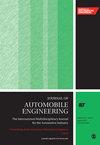Numerical study of the influence of wetting properties on flow characteristics and heat transfer in piston cooling gallery
IF 1.5
4区 工程技术
Q3 ENGINEERING, MECHANICAL
Proceedings of the Institution of Mechanical Engineers Part D-Journal of Automobile Engineering
Pub Date : 2024-07-25
DOI:10.1177/09544070241265400
引用次数: 0
Abstract
Being a crucial thermal management component in an internal combustion engine, the wettability of the piston gallery significantly influences heat transfer performance. This study deeply investigates the impact of the piston gallery’s wettability on heat transfer performance through numerical simulation. Adjusting the wettability parameter, specifically the contact angle, resulted in the observation of varied droplet patterns on the surface of gallery. Surface wettability directly influences oil distribution and adhesion on the piston surface, consequently impacting the piston’s cooling effectiveness. Optimizing the wettability of the oil cavity is expected to improve the cooling efficiency of the piston, contributing to an overall performance improvement. The numerical study revealed that a surface with a certain degree of hydrophilicity facilitates uniform droplet distribution on the surface of the gallery, forming a film-like oil droplet. Such a film of oil droplets effectively enhances heat transfer efficiency, with a well-wetted surface promoting effective contact between the oil and piston surface for more efficient heat transfer. Conversely, a highly hydrophobic surface leads to droplet self-aggregation in the gallery, hindering effective heat dissipation from the piston. Poor wettability prevents uniform oil adhesion to the piston surface, resulting in decreased heat transfer efficiency. To summarize, the wettability of the piston gallery significantly influences heat transfer performance. Optimizing surface wettability enhances piston cooling, thereby improving overall internal combustion engine performance.湿润特性对活塞冷却走廊中流动特性和传热影响的数值研究
作为内燃机的重要热管理部件,活塞廊的润湿性对传热性能有很大影响。本研究通过数值模拟深入研究了活塞廊的润湿性对传热性能的影响。通过调整润湿性参数,特别是接触角,观察到活塞柱表面的液滴形态各异。表面润湿性直接影响活塞表面的油分布和附着力,从而影响活塞的冷却效果。优化油腔的润湿性有望提高活塞的冷却效率,从而促进整体性能的提高。数值研究表明,具有一定亲水性的表面有利于油滴在管廊表面均匀分布,形成膜状油滴。这种油滴薄膜可有效提高传热效率,湿润的表面可促进油与活塞表面的有效接触,从而提高传热效率。相反,高度疏水的表面则会导致油滴在管廊中自我聚集,阻碍活塞的有效散热。润湿性差会使油液无法均匀地附着在活塞表面,从而降低传热效率。总之,活塞槽的润湿性对传热性能有很大影响。优化表面润湿性可增强活塞冷却效果,从而提高内燃机的整体性能。
本文章由计算机程序翻译,如有差异,请以英文原文为准。
求助全文
约1分钟内获得全文
求助全文
来源期刊

CiteScore
4.40
自引率
17.60%
发文量
263
审稿时长
3.5 months
期刊介绍:
The Journal of Automobile Engineering is an established, high quality multi-disciplinary journal which publishes the very best peer-reviewed science and engineering in the field.
 求助内容:
求助内容: 应助结果提醒方式:
应助结果提醒方式:


